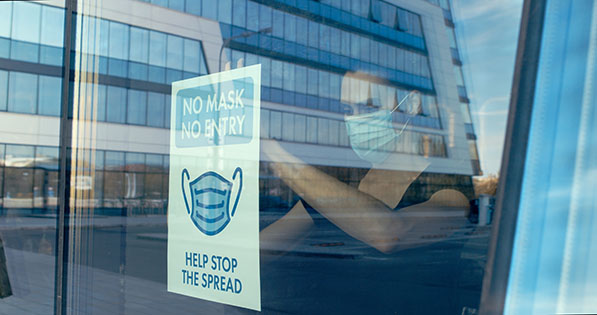Editor’s note: This blog was updated at 5:05 p.m. on December 15 to include additional guidance from the California Department of Public health stating that the mandate applies to all workplaces, regardless of whether they serve or are open to the public.
On December 13, 2021, the California Department of Public Health (CDPH) announced a revision to its Guidance for the Use of Face Coverings that will require all individuals to wear face coverings in all “indoor public settings” regardless of vaccination status. This new order will take effect on December 15, 2021, and is currently scheduled to expire on January 15, 2022.
For about half of California’s population, this new order doesn’t change already existing rules, as several counties in the Bay Area, along with Sacramento, Yolo and Los Angeles counties, have had some form of indoor face covering mandates regardless of vaccination since late July or early August. However, as previously reported, the current Cal/OSHA COVID-19 emergency temporary standards (ETS) permit an employer to relax its face covering rules for fully vaccinated workers upon showing proof of full vaccination if they aren’t subject to a stricter local order.
The Cal/OSHA ETS does, however, require employers to provide face coverings and require their use when subject to a CDPH order — which means the new CDPH face covering guidance revision effectively eliminates the Cal/OSHA face covering flexibility for “indoor public settings” that weren’t already subject to a local public health order requiring face coverings.
Unfortunately, the order doesn’t define “indoor public setting,” however the CDPH has published guidance on the order. Although the guidance still doesn’t fully define what it means by “indoor public setting,” it does update the exceptions to include only those times when a person is alone in an office or room indoors, and on December 15, posted another clarification that this order applies to non-public facing workplaces as well. Employers should consult legal counsel regarding whether their workplace should comply with the CDPH order or continue following the Cal/OSHA ETS flexibility. Cal/OSHA also has yet to provide guidance how the CDPH order impacts the ETS.
Employers should remember that with all disability or medical condition issues, any accommodation should be medically advisable, meaning the employee has a medical certification of the disability and their health care provider has indicated that an alternative face covering is medically advisable. Cal/OSHA ETS requires that any accommodation still effectively block respiratory droplets, such as a face shield plus a neck drape. Employers with issues related to reasonable accommodations under this rule should consult with legal counsel for solutions.
Lastly, should the order apply to your workplace, the Cal/OSHA ETS provides specific rules for what constitutes a face covering. Under the ETS, a face covering is a surgical mask, a medical procedure mask, a respirator worn voluntarily, or a tightly woven fabric or non-woven material of at least two layers. Scarves, ski masks, balaclavas, bandanas, turtleneck, collars or other single-layer fabric face coverings are not permitted.
Matthew J. Roberts, Employment Law Counsel/Subject Matter Expert
CalChamber members can read more about Cal/OSHA Emergency COVID-19 Regulation in the HR Library. Not a member? See how CalChamber can help you.





